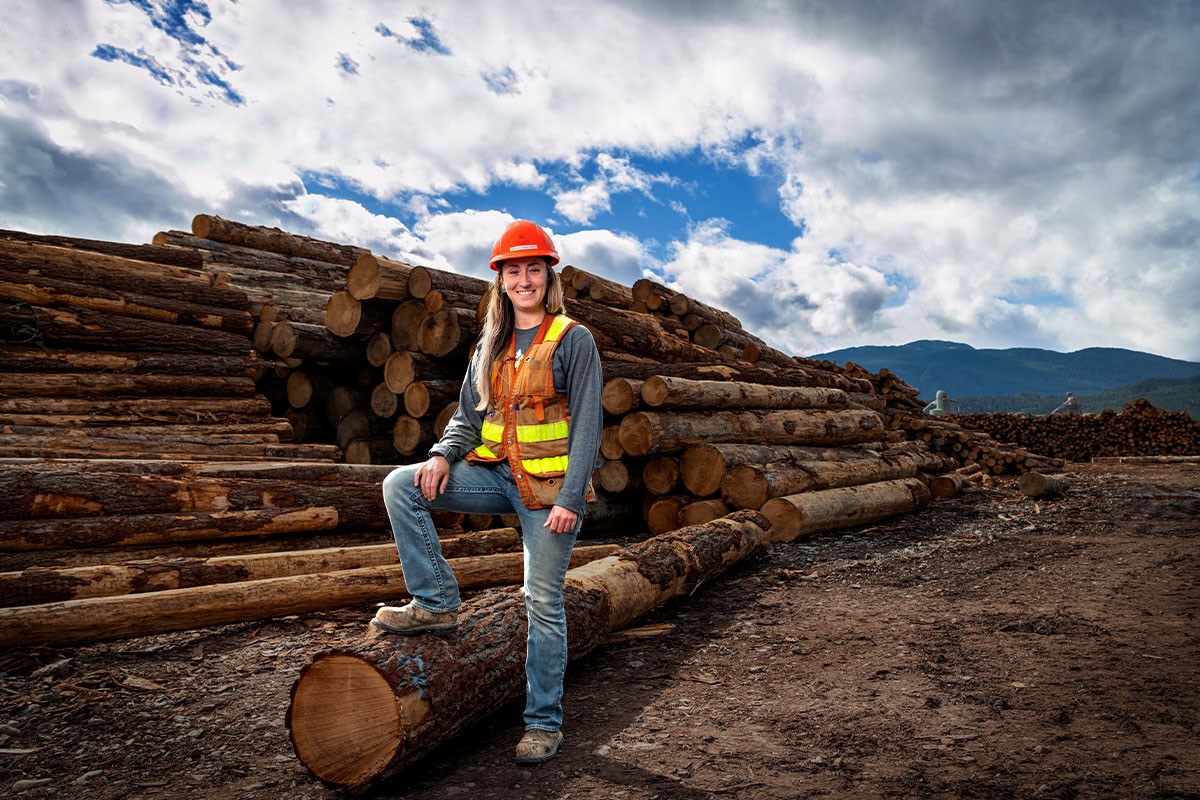
Challenging but rewarding: Q&A with Skeena Sawmills’ Jessica Hochins
March 3, 2022
By
Ellen Cools

Jessica Hochins first got into the forest industry through school, when she discovered the forest ecosystem management technician program at Confederation College in Thunder Bay, Ont. Since then, she has never looked back. After graduating in 2013, she worked for multiple sawmills in the woodlands department, planning and silviculture, ultimately ending up in operations supervision at Skeena Sawmills in Terrace, B.C. Today, she still remembers what her program coordinator told her: the forest industry is challenging but rewarding – something she wholeheartedly agrees with.
Canadian Biomass: What first got you involved in forestry?
For me, I didn’t have family that was in forestry or anything like that. It was actually a friend who mentioned that maybe I would like forestry because of my love for the outdoors. So, I started researching forestry programs and I found the forest ecosystem management technician program at Confederation College in Thunder Bay, Ont. I did my research looking at the program and I really liked it; I thought it would be an opportunity for me, so I went full force in. I did my college diploma, and then I transferred to Lakehead University after doing some research into that, too. I got my Bachelor’s of Science in forestry with a specialization in forest management from there. So, in four years I did the diploma and university degree.
Canadian Biomass: So, how did you end up in your current role?
I graduated in 2013, and I headed out west. I started my career as a summer student in Alberta, and, basically, I’ve been in industry ever since. I worked for sawmills in the woodlands departments, and I tried out planning and silviculture, and ultimately landed in operations supervision. That’s my current role. On top of operations supervision, I’m also responsible for the safe certification program for Skeena Sawmills, and I am the environmental management system coordinator for two different certification programs – the first being the Sustainable Forest Initiative (SFI) with the sawmill and then the Sustainable Biomass Program (SBP) certification for Skeena BioEnergy [the pellet plant].
Canadian Biomass: What do you like most about your role?
I like the diversity. With operations supervision, there’s lots of fieldwork associated with it. So, I really like being in the field a lot, but I also have office time. I like working for a small sawmill as well, because then I get opportunities to do multiple things at once – it’s not just a one-lane opportunity.
Canadian Biomass: Are there any particular mentors that have helped you reached this point in your career?
There’s a few I can think of, for sure. My sponsoring forester that I had in Alberta, she was very integral in the initial development of my career when I started. She got me into operations supervision, so I’m super appreciative to have had a mentor like that. A few other people also encouraged me to grow my career and make some pretty big career choices in the last few years.
Canadian Biomass: How important do you think mentorship is for encouraging other young women to get involved in the industry?
I think that mentorship is 100 per cent important. That’s how I got to where I am today, and I always encourage younger people that I work with to reach out and have that mentorship. Becoming an RPF and having that sponsoring forester, I think that’s a key way you can have mentorship. But, I’ve also worked for some companies that strive to have a strong mentorship program and delivering on that is key.
Canadian Biomass: Do you find there are particular challenges or hurdles for women in the industry? Any recommendations for how we can address them?
I certainly have experienced some challenges in my career. It being a male-dominated industry, there’s ways that I’ve had to navigate certain situations where maybe I felt that my voice wasn’t heard or I had to speak up a little louder than some other colleagues. So, I’ve certainly faced some challenges but I’ve grown professionally and as a person from them, and fortunately I’ve had management that supports me if I speak out about issues that I’m having. Finding PPE that fits appropriately is also an issue that I’ve had. For example, having hi-vis jackets provided to staff, and I got a size small but I’m swimming in it. And footwear, I definitely have to dig deep into the internet to find appropriate ones.
Canadian Biomass: What would you say to women who are looking to get involved in forestry or women who are in forestry and want to move up to a leadership position?
I think for younger women, it’s important to do your research. Stay curious and remain open to different ideas. And if you have an interest in anything regarding forestry, I think it’s important to ask questions. Don’t be afraid to lean on others in the industry and learn more before you get into it. I remember my program coordinator saying on one of my first days that forestry will be one of the most challenging but rewarding programs that you’ll go through, and I think that rings true. I definitely see the rewards with it. And for women looking to move into management roles, I think you’ve got to put your foot forward and speak up if you would like to have the opportunity to move ahead with your career.
This interview has been edited for length and clarity. This post is part of CFI, Pulp & Paper Canada and Canadian Biomass’ Women in Forestry series celebrating International Women’s Day on March 8. Find more content here and follow us on social media with the hashtags: #WomeninForestry, #IWD2022 and #BreakTheBias.
Remember to join us for the Women in Forestry Virtual Summit on Mar. 8 at 11 am ET/8 am PT! It’s FREE to register. Sign up now!


